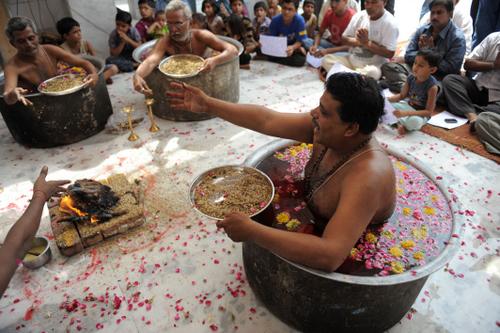New studies show role of caste and creed in Indian inequality
Indian Hindu Brahmins perform a ‘Parjanya Yagna’ ritual to appease the ‘rain gods’ at The Shree Paanchnath Mahadev Temple in Ahmedabad on June 26, 2011. Two new studies have shed some light on the role of caste and religion in income inequality. Not surprisingly, Brahmins, the highest caste, enjoy a disproportionate share of the country’s wealth.
In the wake of the flurry of articles on India's (few) Dalit millionaires, Sunil Jain delves into two new studies of the role of caste and religion in economic inequality for the Indian Express. It's worth a read, if only for the income numbers. But I'm not sure Jain gets all his conclusions right in what appears to be yet another argument for letting private enterprise take over the battle against inequality.
With phrases like "discrimination seems apparent from the bald facts" and "when you go a bit deeper," Jain implies that the role of caste and creed in inequality has been exaggerated and these new studies expose a different picture. I haven't read the studies, so that might in fact be true. But the examples that Jain cites from the statistics aren't too convincing.
Here are the "bald facts":
The Scheduled Castes (i.e. Dalits) and Scheduled Tribes (i.e. aboriginal tribes) accounted for 22.9 percent of the population, but just 15.4 percent of income.
Lower caste Hindus called the Other Backward Classes accounted for 35.6 percent of the population and 32.7 percent of income.
Upper caste Muslims accounted for 4.5 percent of the population and 4.2 percent of income.
And upper caste Hindus accounted for 27.7 percent of the population and 38 percent of income.
Fair enough so far. But here's how Jain reads the rest of the data:
When you go a bit deeper, the discrimination gives way to a more sobering analysis where factors like education, location and job-type matter more than just caste — a Hindu upper-caste household’s annual income goes up from Rs 27,650 when the head of the household is illiterate to Rs 135,535 when he’s a graduate; Muslims in Uttar Pradesh had an annual household income of Rs 53,351 in 2004-05 versus Rs 60,645 for all-India; SC/STs in Uttar Pradesh had an income of Rs 39,713 versus Rs 43,314 for all-India; for Hindus in general it was Rs 60,630 in UP versus Rs 64,413 all-India.
I'm not saying Jain has an axe to grind here. I don't know him or his politics, and there's a lot of nuance in what he says later on in the piece. But it does seem like he's ignoring a fairly obvious point here: How does discrimination against Dalits and Muslims affect education, location and job? And what are the numbers? Presumably, if illiterate upper caste Hindus earn far less than literate ones, it's important to note whether or not a greater percentage of upper caste Hindus are literate than lower caste Hindus. (Frankly, I don't know the answer, though I have my suspicions). What are the percentages for type of job?
If you're keen on the subject, read Jain's whole piece here.
